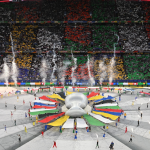
Inter Milan and Ajax had to change their jerseys in Champions League debut
Yet another case of infringement of the stringent UEFA Equipment Regulations
September 14th, 2022
Champions League is back, UEFA's banned jerseys are back. Two highly anticipated jerseys, Inter's world map away jersey and Ajax's third made in collaboration with local brand Daily Paper, were due to debut last night but all did not go according to plan. In fact, both jerseys broke the stringent UEFA Equipment Regulations that have already claimed illustrious victims in past years, including Inter itself having to remove the snake from its Champions League kit last season.
This year, on the other hand, Inter had to dilute the turquoise drawing on the globe, making the design much less defined and legible, effectively ruining the basic concept. UEFA has extremely strict rules regarding the use of patter on game jerseys to visually unify the kits of all teams in European competitions. Inter, however, will be allowed to use the away jersey in Serie A and Coppa Italia without modification, doing justice to the design created by Nike.
Ajax, too, is no stranger to controversy with UEFA for their Champions League's jerseys, as last season it had to change both its first and third jerseys, the one dedicated to Bob Marley. The jersey in collaboration with Amsterdam-based brand Daily Paper, on the other hand, broke UEFA rules by having two logos, that of Daily Paper and adidas, the former of which was removed from both under the team crest and from the backneck. Also the font pattern was simplified for the jersey numbers and names, replaced by a more traditional black.
As is the case every year, the question arises as to why many technical sponsors make designs that will then certainly be banned by UEFA, forcing them to make changes that distort the original concept. At the same time, such stringent regulations make major creative efforts on the part of clubs useless, as they cannot rely on the most important stage in international soccer to showcase their new kits. Perhaps a compromise between the parties should be found.






















